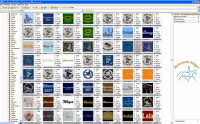A continuous workflow in an embroidery shop, independent of its size, depends on many details. The workflow can get stuck due to inconspicuous factors, such as habits, irregular working processes and poor job planning. Also, basic factors such as the layout of the workplace and the careful selection of tools and business partners may minimise interruptions and down-times.
You should organise your different working areas following the logical sequence of the working processes. Ideally, you need an area for incoming goods, where the quantities of the delivered goods can be checked and transferred to the storage area or directly to the jobs. It can also be an advantage to store the embroidery threads somewhere easily accessible and sorted by colour codes in this area. You could pick all necessary materials, such as threads and appliqué fabrics, for a job in a single step. The complete textiles and all the accessories are then entered in the queue of the embroidery orders.
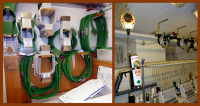
Frames hang to hand on the wall near the framing device (left) – in front: an adhesive spray, fixed to the wall with a clamp; the cap-drive is attached below the ceiling directly over the machine (right)
The next station is the job preparation. Here, the textiles are prepared for embroidery. Elements such as ruler, tools for marking, embroidery backings, framing devices and frames are stored here, ready to be used.
The next station is the machines. After the machines, you need a working place for finishing tasks, such as removing the backing and folding the textiles. This place should be near the job-preparation area. Frames can easily be returned to this area, where they are needed. At the end, you need a place to package the jobs for delivery or pick-up. Avoid unnecessary paths.
System for commissioning the textiles for the different jobs
You should create a system for commissioning the textiles for the different jobs. Foldable and 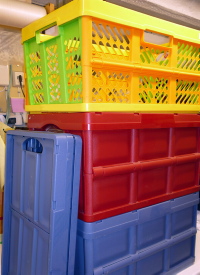 stackable trays/baskets are quite practical. On one hand, they need only little space, also, when a larger volume of textile is needed, and when not used, they can be stored in a space-saving manner. However, boxes/baskets with wheels also have benefits – there is no need to carry heavy trays. The use of trays in different colours can help assigning the jobs to different departments, machines or employees.
stackable trays/baskets are quite practical. On one hand, they need only little space, also, when a larger volume of textile is needed, and when not used, they can be stored in a space-saving manner. However, boxes/baskets with wheels also have benefits – there is no need to carry heavy trays. The use of trays in different colours can help assigning the jobs to different departments, machines or employees.
Quality of consumables
Do not economise on the quality of the consumables! Take care to use embroidery threads of good quality. Beginners are often confused by the huge offer of threads and end up buying the cheapest offers. However, this behaviour can be much more costly at a later stage. One reason is that with cheaper threads it often happens that the same colour code in different batches has visible colour differences. Of course, it is sometimes possible that there are some slight colour shifts with quality thread, especially with nature fibres such as cotton or viscose. However, we have not seen any such case in the past several years.
Another argument is the availability of the threads: how quickly can you get the thread when you need it urgently? Recognised companies often deliver within two days. With good planning of your jobs, you still may start your production on time.
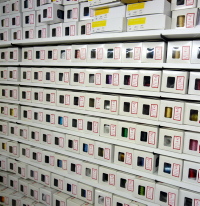
Wall lined with shelf units made with brackets and rails for storing embroidery threads in the original boxes with viewing window and coding.
The same applies for the bobbin thread: not the price, but a smooth process on the embroidery machine should be the decisive factor. Pre-wound bobbins are well suited. There are big differences between the variety of offered bobbin threads – in price and in how regularly the thread unwinds from the beginning to the end of the bobbin. At first sight, self-wound bobbins appear cheaper, however smooth running and regular tension from the beginning to the end of the bobbin are not achieved. This will be evident in the quality of the embroidery. Furthermore, you should not underestimate the time used to produce the bobbins. On multi-head machines, you have to replace bobbins that are not completely used, if you do not want to interrupt the working process already at the beginning of the production.
The quality of the embroidery depends on many small details – one of these is the embroidery backing. There is no magic formula – you will need different types of backings, depending on the job. The tear-away backing is very popular, due to the quick way of removing the residues. On some embroidery fabrics, you achieve a better quality with cut-away backings, especially with elastic and softer materials. Using the correct cutting technique, this task can be done quickly and cleanly enough to be cost-effective.
Production process on the machines
Before you begin the production, check if all the materials are available in the necessary quantities. This includes upper and under threads, embroidery backings and, of course, the textiles. Do not forget the appropriate needles.
Are there appliqués in the embroidery design? At this moment, they should already be pre-cut and ready to be used.
If there is only one link in the chain missing, you may have to interrupt the production or you may detect after preparing the machine that you still cannot start to embroider. The time for preparing the machine, at least, is lost for this job and you will have to recover it later.
Prepare your machine thoroughly. Make sure the right needles are in the correct position and that the upper- and under-threads have the correct tensions. This can be done by good judgment or you can use special devices to determine the tensions of the upper- and under-threads.
Are there thread-breaks occurring at the same needle at different points of the design but everything else works smoothly? Replace this needle and the problem should be resolved.
The better you prepare the production, the better you avoid bad surprises during the production process.
Implement your own standards within the company
If you do not work alone in your shop, many misunderstandings and wrongly produced goods are avoidable – when every employee follows the same working routines. These routines can be: Embroidery designs are always rotated already in the software, e.g. for caps 180º, or all designs are saved in the normal position and rotated on the machine.
Thread cones are removed and stored in the correct boxes after finishing the production of an order or at the beginning during the machine set-up.
Such internal company rules maintain a smooth workflow.
Heights of working tables
Are the heights of the working tables correct in the different areas? For every machine type, the working height is different. It is easy to prevent back pains for you or your employees caused by stooping, which could even lead to loss of working hours. Create possibilities to change the heights of the machines.
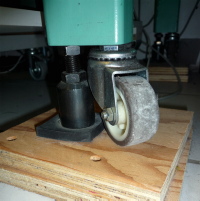
With just a few centimetres of support below the machine feet, this machine was lifted to a user-friendly working height. You may also buy a height-adjustable seat that can easily be lowered or raised. With this, you can sit in an upright position, e.g. for threading the needles.
The same applies also to the other workplaces. A framing device for T-shirts usually has another working height than a device for framing sleeves or cap backs and the optimum height for a cap-framing device can once again be different. Of course, these heights also depend of the heights of your employees. Therefore, height-adjustable and stable working tables are ideal.
From time to time, you need a larger table surface for an order, than usually. Retractable tables that only occupy space when they are needed are a good option. They can be folded out at the place where you actually need more space.
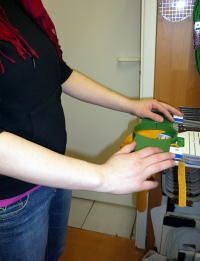
At this working height, the arms remain in a relaxed position – the angle between upper- and lower-arm should be greather than 90º.
Maintain your working tools
Maintain your machines! Starting with the daily tasks such as cleaning the hooks and subsequently lubricating, continuing with the weekly maintenance following the user manual up to the tasks that are necessary every now and then. Shouldn’t you do some of these tasks by yourself? Call the customer service with anticipation of what could happen. The possibility of a sudden failure with a very well maintained machine is far smaller than with a machine that is not maintained carefully.
Reading embroidery designs
Do you still read your embroidery designs with floppy disks? Floppy disks as memory media are still quite common. On many machines that have no USB connection or something similar it may be possible to connect directly to the PC. Transferring embroidery data ‘online’ is by far quicker than writing and reading floppy disks. With several machines, it can even be possible to send the designs from a single PC. Ask your machine provider for solutions. So you can finally eliminate the ‘sneakers network’.
PC
Is your PC still up-to-date with the requirements of your shop? It is not always necessary to have the latest systems; however, you should observe the developments of this sector. It can easily happen that you cannot get any more software for your PCs after some years. By updating, for example, your embroidery software every couple of years, you can maintain an efficient working environment and will not lose your competitiveness.
Is your PC set up correctly for the applications you use? This question can be answered by your software provider. Working with a slow-working system can be very time-consuming.
Do you often have problems with the wrists, due to continuous work with the mouse? Try to use a tablet and a pen. The pen takes the function of a mouse and your hand position is the same, as if you were writing with a pen or a pencil.
Embroidery software
Take advantage of the possibilities of modern embroidery software. Create different designs for different fabric types directly with the software. Then you do not have to adjust the length and width of the stitches and other parameters every time.
Use the automatic functions you consider useful. However, do not expect to create a complete embroidery design without adjustments with automatic tools. You may lose much more time for editing, afterwards.
Import the names for letterings for teams or company shirts from a digital file from your customer. Therefore, you do not have to type all the names by yourself and the responsibility for the correct spelling is your customer’s. Usually such embroidery data can be sent directly to a machine, even when a design will have to be embroidered with many different names. The file is retrieved only once and has all the information. The single embroidery design data for the individual name is automatically created, similar to the process of mail-merge letters. 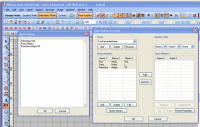
Input form of an embroidery software. It is also possible to import a name list, copying and pasting it from another program.
Storage of embroidery data
Where are these or the other embroidery data currently? Did you ever ask yourself this question? It is quite easy to lose the overview much quicker than ever anticipated!
Saving the embroidery designs on electronic storage media is certainly a quick and space-saving option. No space is used for storing punched tapes or shelf space for folders with floppy disk envelopes or disk boxes. However, it is necessary to use a system to find the designs again. Of course, you can set up folders in Windows by category, customer, year or other criteria. Even so, after not too many years, you will have your problems finding your patterns.
A design database is very helpful. Every single design is registered with specific keywords, such as category, search words, customer name etc. Later, the design can be found by using these keywords. The little extra work of a few minutes during order processing is well worthwhile. Recreating a design you have not found or for which data were destroyed after being stored for a long time on a floppy disk is far more time-consuming.
This database search shows all the designs saved with the key word ‘horse’.Administration
Organise your administrative tasks, in order to do much more with much less effort. Set up the customer database in bookkeeping software. Once set up, you can quickly create offers, delivery notes, invoices and reminders within the software. Furthermore, you have access to historical data. If your customer places his order at the phone with the comment, “the same way as last time”, you can quickly check and maybe clarify other questions. In many cases, you can save a second call to the customer.
Always write your invoices after finishing the order. Never deliver goods without the invoice – you will need the payment to come up with your responsibilities.
Manage your business account online, so you don’t lose time outside the company. Paying bills and following up incoming payments can easily be done on a daily basis. Offer your customers the possibility to pay without cash. You avoid going to the bank and nobody likes to have large sums of cash in the company.
___________________________
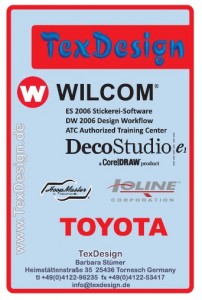 About the author:
About the author:
Henry Stümer is Manager of the company TexDesign. Besides the main business of consulting and distribution in the embroidery field, TexDesign also does local business in garment decoration. TexDesign was founded in 2002 bij Henry’s wife, Barbara, who is responsible for the creative side as well as training. You can contact Henry or Barbara Stümer at info@texdesign.de.

